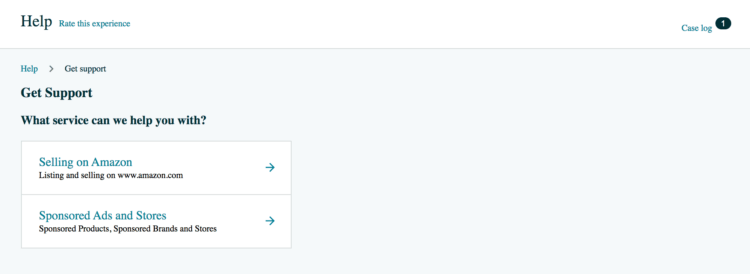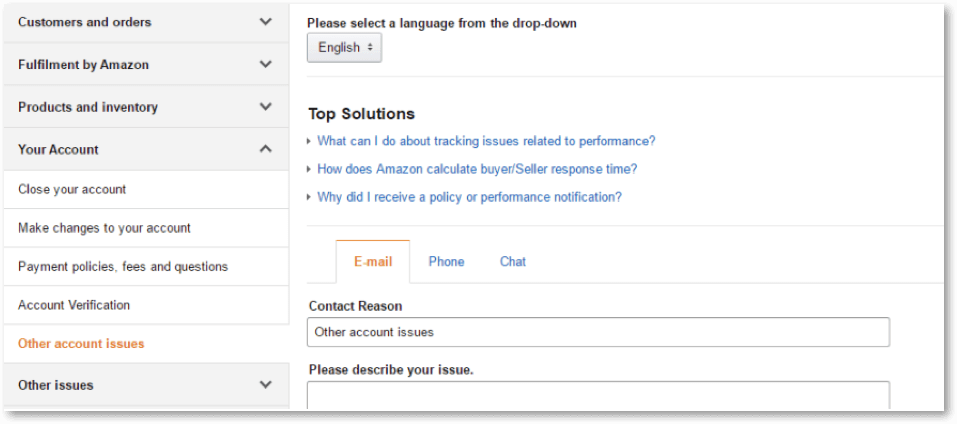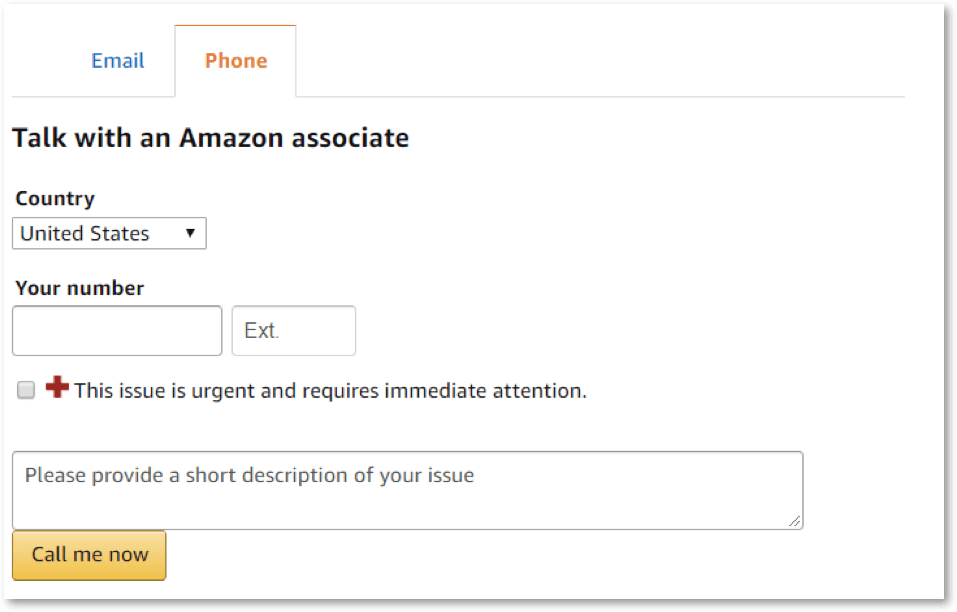Each year more than a million new sellers join Amazon. Just a few years ago, when seller problems rose, you contacted Amazon and quickly solved your issue. Nowadays, with so many new sellers, if you need to contact Amazon seller central – take a number.
Amazon tells you that as a seller, “Amazon’s support is always at your fingertips.” But in the real world, trying to communicate with them can be extremely frustrating. Sellers feel that they are “talking to the hand” and when they do get a representative, they are continually misunderstood.
Here are a few tips to help you stay sane while opening a case with Amazon and actually resolving your problem. Let’s take it step by step.
1. Email first. It’s always good to have a papertrail.
Yes, sometimes your issue can be super frustrating and you want answers fast, but it’s best to start communicating by email first because having the papertrail with the proof of your conflict can be helpful for future reference.
Amazon Seller Central DOES NOT have:
- An Amazon seller central support phone number
- An Amazon seller central support email address
- Amazon seller central support chat options
So you have to go through their site.
When approaching seller central support by email, log in your seller central account and follow these steps:
sellercentral.amazon.com
1. Log in to your Amazon seller account and click on “Help” in the top right corner of the screen.

2. In the pop up box that appears, click “Get Support” under the “Need more help?” section. See screenshot below:

3. Amazon will ask you “What service can we help you with?”
Click “selling on Amazon” for any general inquiry that is not related to sponsored ads or your Amazon store.

4. Browse through the list of options matching the problem you need assistance with, and choose your issue.

5. They will ask you whether you would like a phone call back, or an e-mail. Choose e-mail.

Once you complete a query, you will receive an Amazon seller central support ticket, aka Case ID. Amazon seller central may call you anyway, even though you asked for an email response. If they do, keep their phone under “seller central” in your contacts so you know it’s them next time they call. Usually they call from a +206 area code. (Seattle.)
When they do finally contact you, it’s best to take these few tips into account.
2. Preparation in everything - always be ready for any detail the rep might need
It helps to have your problem written down so you can be super prepared when a rep calls you. Information such as seller account details, billing information, ASIN numbers or UPC (so they know exactly which product you are having trouble with,) shipment numbers ready, (if you are having shipments issues) as the representative might ask you for it.
Before talking to the representative, make sure that you have your unresolved case open on the computer screen, especially if you are calling to talk about an order or a dispute that you have with a customer.
Attach screenshots of all the trouble they need to shoot, and all the details you can amass for the call. Even details that don’t seem crucial to you may surprise you as the details that solve the case.
3. If your case is urgent - there are a few categories that get immediate attention
If your problem is dire and you are chomping at the bit, Amazon Seller Support does have an Urgent Help Needed solution. Certain cases get priority and Amazon will contact you ASAP. But this happen only in cases such as:
- Your account has been hijacked or compromised in some way.
- Pricing errors or prices that were not updated within 24 hours.
- Feeds or product listings that you uploaded and were not computerized 24 hours after uploading.
- Any ASIN issues that are brand registered.
4. Knowing the lingo to use when speaking to a rep can speed things up!
- “It’s not me… it’s them…“

Amazon’s MO always has and always will be about “the customer’s experience.” As far as they are concerned the customer is the sun and Amazon revolves around them. Amazon’s dogma is making sure customers have the best shopping experience, making it as easy and fun as possible for them to keep on coming back.
Third-party sellers? A star just a little more distant than the sun. So if you can find a way to tell the representative how your problem is affecting the customer experience, you are much more likely to get an effective response.
For instance:
The “less effective way” – A hijacker is stealing my photos and changing them on my site which is hurting my account. My sales are depleting and revenue has come to a full stop.
The “more effective” way – The lack of photos on my account is having a negative effect on the customer’s experience. They can’t see the product they want to buy which makes it harder for them to make the purchase. Please help me fix this problem to improve the customer’s experience.
Always reflect the problem on how the customer’s experience is the one hurting here, not you. The best way to present you issue is by letting Amazon know that THEIR customers will be hurt as a result of of these counterfeit products
- “Please take ownership of your problem”

Many start up companies and organizations train their employees to “take ownership” of any problem that arises, find the best way to solve the issue and bear accountability.
If you are running in circles going back and forth phone with Amazon seller central, you can say:
״Thank you for being on my case. We have been working on this issue for a few weeks now and the problem hasn’t been solved. Please take ownership of this issue and help me crack this problem”.
- “Please escalate my case to a different team”
If it seems that your case is stuck with seller support central and not going anywhere, you can ask “escalate your case to the captive team.” You will reach a higher-level of support comprised of agents who have a wider set of tools and know better to resolve issues that are slightly more complicated.
Amazon representative will not always operate at your request so quickly, so make sure to keep requesting until that happens.
5. Don’t open a new case for the same issue if you are already under review.
As frustrating as it is, no need to open a new case if your problem has not been solved. Go back to the case log and check for any news.You can also follow up on the case to check if there is any progress with it. It might help get a quicker response. If your case has been taken care of but not to satisfaction, ask Amazon to keep the case open. If the case has been closed, re-open it rather than begin a new one. If the case was closed, and you cannot reopen it, create a new case, with the subject “Regarding case ID 12345”
Amazon is very strict with their rules and regulations, everything has to go by their book. Any case that hasn’t been handled “their way” can not only stay the same but might be closed entirely.
One problem at a time
When opening a case, point to one problem. In general, keep your cases concise and short as possible, with a simple language and terminology. Filling a form with all of your issues can be confusing to handle. Amazon prefers you open a new case for each problem that arises.
6. When all else fails, crowdsourcing can actually be super helpful.
While you are waiting, you can always ask for help from other sellers. There are many Amazon seller groups on Twitter and Facebook as well as the Amazon Seller Forums in Seller Central. They may have the experience you need to solve your problem.
7. Stay persistent, cool and patient
No – we are not here to teach anyone manners but… Seller Support Central can be frustrating to deal with when your business is suffering and only they can solve the problem. Though it may cause anger and frustration, we learned that the secret is really to stay calm, and speak to them with patience, clarity with every single detail ready to be handed. If the case wasn’t resolved to your satisfaction, keep in touch with Amazon until it is. Persistence is key when dealing with Seller Support.
In the end…
think of it as a temporary hurdle before business goes back to usual again. Using the tips in this blog will help you get through your case much faster so you can go back to focusing on sales and revenue after successfully braving all the hurdles that managing an Amazon online business can bring.



